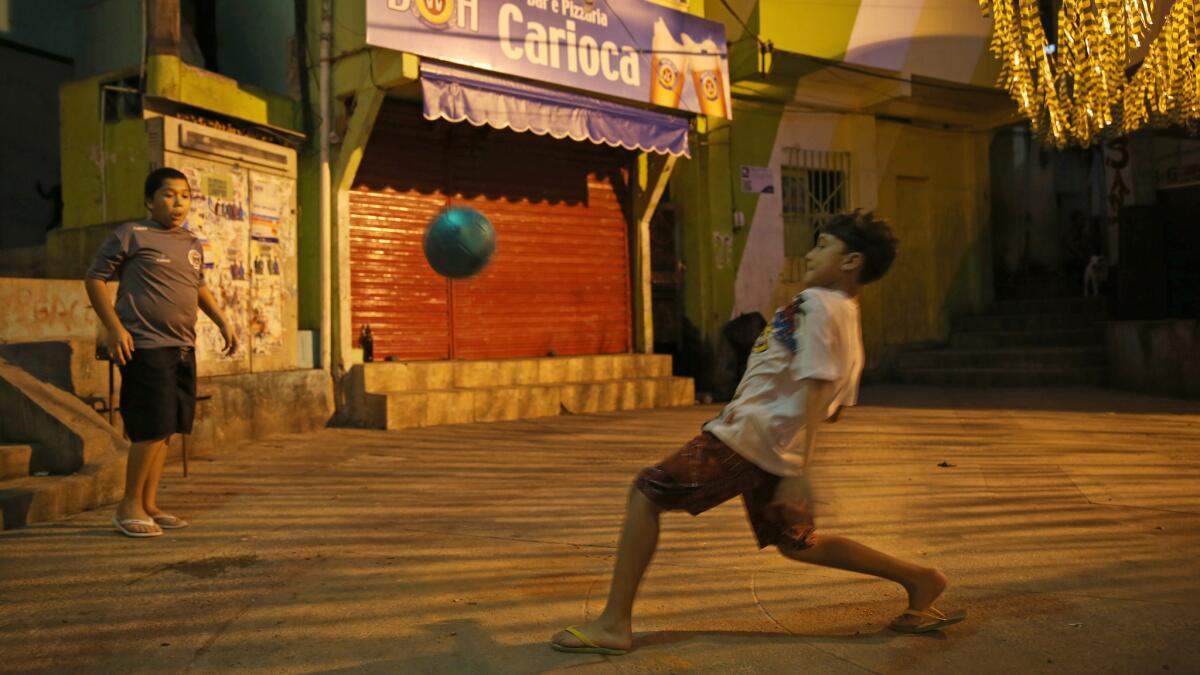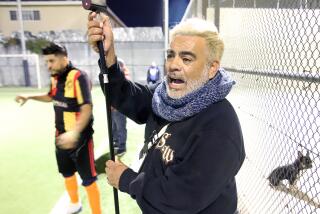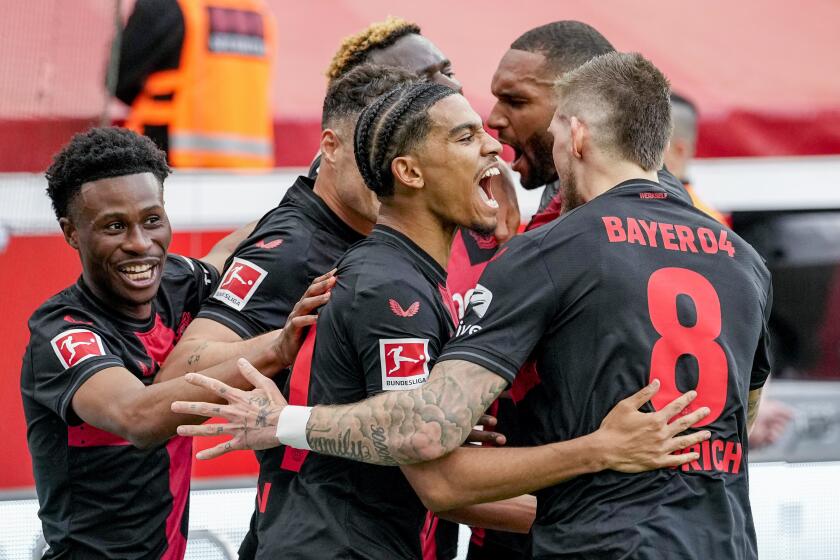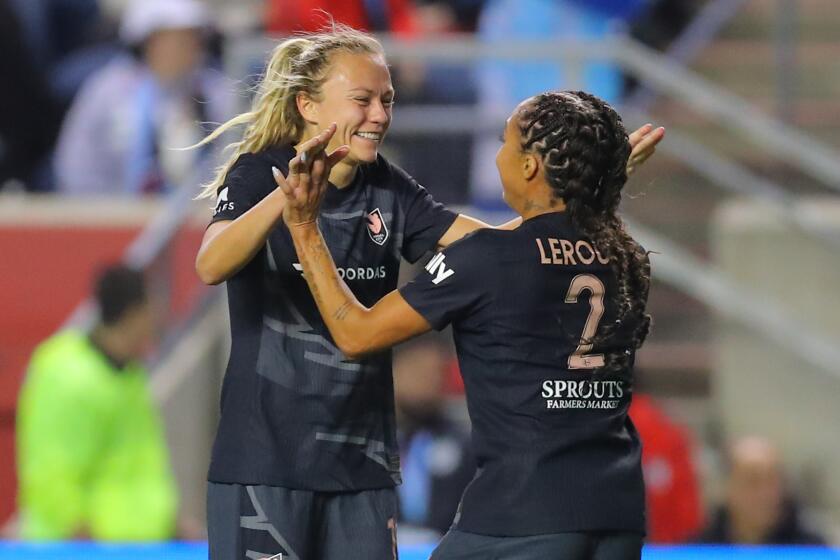In streets of Brazil, the soul of soccer is a long way from World Cup

Yuri Peterson has the speed and elusiveness of a top striker and the vision and touch of a playmaking midfielder.
But what really marks the tiny 11-year-old as a soccer player are his feet. The skin on the sides of his big toes has been rubbed away by playing barefoot on the concrete court of the overcrowded housing project where he lives in Sao Paulo’s South Zone, a common malady for young players here.
“It does happen,” he says with a shrug as he looks down at this feet. “I play all the time without shoes.”
So do many boys in Brazil, where soccer games are plentiful but shoes and open fields are not.
Neymar, Fred and Hulk, the top players on Brazil’s World Cup team, all learned the game playing barefoot in the street. So did Romario, Ronaldo and Rivaldo, who won four World Cups among them.
Pele, widely recognized as the greatest player of all time, was too poor to afford soccer boots and he didn’t own a real ball either.
“We used to [make] a ball with socks,” he remembers. “Get my father’s socks, my mother’s. Then we’d fill them with paper and play in the streets.”
It wasn’t as if he had a choice. In few places is a sport more integral to the national identity than soccer is in Brazil. Just check out the flag. Looks like a soccer ball, doesn’t it?
“It’s everything,” says Sergio Roberto Da Silva, a former minor league soccer player who now runs a sports club in San Paulo. “It’s happiness. It’s enjoyment. Brazilians without soccer, they don’t live.”
The World Cup, which opens its monthlong run on Thursday in Sao Paulo, hasn’t sparked the same fervor. The government spent more than $11 billion during the seven-year run-up to this tournament, yet many projects remain unfinished while others were never started. Many people here refer to it simply as “the robbery,” a misuse of money they say could have been better spent for schools, hospitals or public transportation.
On the narrow street that leads to the soulless concrete tower where Peterson lives, three men were stringing yellow, blue and green paper banners late Sunday, the only indication the country’s national team was about to play. On the same block four years ago, when the World Cup was held in South Africa, Brazilian flags hung from houses and flapped from car windows and the logo of the Brazilian soccer federation was painted on walls.
“People are tired of the World Cup,” says Rafael Ambrosio, a resident of South Zone. “Maybe it will change when the games start.”
The games are already underway inside the housing project, where Peterson and about a dozen friends chase a pink rubber ball around a fenced-in concrete court marked like a soccer field. If there are teams, those allegiances change quickly with the player nearest the ball often deciding which end to shoot at.
This is what passes for street soccer today in places like Sao Paulo (pop. 11.8 million), the largest city in the Southern Hemisphere and one in which cars and buses clog the warren of tangled streets, driving kids to the enclosed soccer courts that dot many neighborhoods.
The court where Peterson plays, painted a light blue, is 20 yards wide and about 45 yards long with green posts at each end to mark the goals. Graffiti covering the walls around the court claims the territory for the city’s dominant gang, which carefully monitors everything that happens in its neighborhoods but rarely interferes in the soccer games.
That’s not the case 45 minutes away in Itaquera, near the Arena Corinthians stadium where the World Cup will kick off. There, Joel Vitor Oliveira Gonsclaves says, the concrete court in the slum where he lives has become an open-air drug market. And when there are pickup games, the number of kids who show up to play often means long waits before the skinny 14-year-old is picked for a side.
“We wish our neighborhoods could be safer,” says Oliveira, who rides his bike to Da Silva’s sports club, one of the few places that boasts two full-sized grass fields. Da Silva says his club has taken 800 children like Oliveira off the streets, giving them food while also feeding their appetite for soccer.
“I’m very proud of that,” says Da Silva, who has to beg for funds to keep the club operating. “Doing something like this is priceless. And it also doesn’t pay.”
But it’s these poor neighborhoods that are the richest in soccer players.
“Brazil is unequivocally the most successful and celebrated football nation,” says David Goldblatt, author of “Futebol Nation: The Story of Brazil Through Soccer.”
“That has got to be your starting point. And as with everything you need to start at the bottom, not the top.”
Galaxy midfielder Marcelo Sarvas, who learned the game in Sao Paulo, said he rarely saw a grass field when he was growing up. Instead he played games of five on five, shirts versus skins, with a sandal or a rock marking the boundaries of the goal.
Teammate Juninho had a similar childhood.
“We all grew up playing in the street. That’s the custom,” he says. “With small goals in the street. And from there we got better.”
Getting good enough to someday play on a grass field was something Sarvas and Juninho aspired to.
“That makes you better,” Sarvas says. “When you see all the nice stuff, the nice fields, it makes you hungry. All kids dream of becoming a professional soccer player.”
Sarvas is one of four players from Sao Paulo on the Galaxy roster, part of a larger group of players Brazil has shared with top-flight leagues all over the world.
The country’s leading export may be iron ore but it’s best known as the top producer of exceptional soccer players.
This season there are 18 Brazilians, including national team goalkeeper Julio Cesar of Toronto FC, playing in Major League Soccer, the top U.S. league. And just two of the 23 players on Brazil’s World Cup team play club soccer at home, while six Brazilians play in the English Premier League.
In his book Goldblatt writes that nearly 1,200 Brazilians played professional soccer outside their country in 2008, the high-water mark for exports. Collectively they were worth nearly a quarter-billion dollars.
“Is it because they are Brazilian? Or do they become Brazilian by playing barefoot in the street?” Goldblatt asks.
It sounds like a trick question, like trying to separate the chicken from the egg. In reality, they are one in the same since all streets leading into Brazil also lead out again.
Tiny Yuri Peterson, who would one day like to play for Barcelona, hopes soccer provides a way out for him too. “I like it,” he says shyly. “Everyone likes soccer.”
Twitter: @kbaxter11
Bevins is a special correspondent for The Times.







